Thermo Fisher Scientific MEGAscript™ Kit User manual
- Type
- User manual

USER GUIDE
MEGAscript® Kit
Catalog Numbers AM1330, AM1333, AM1334, AM1338
Publication Number 1330M
Revision G

For Research Use Only. Not for use in diagnostic procedures.
Information in this guide is subject to change without notice.
DISCLAIMER
LIFE TECHNOLOGIES CORPORATION AND/OR ITS AFFILIATE(S) DISCLAIM ALL WARRANTIES WITH RESPECT TO THIS DOCUMENT, EXPRESSED OR IMPLIED,
INCLUDING BUT NOT LIMITED TO THOSE OF MERCHANTABILITY, FITNESS FOR A PARTICULAR PURPOSE, OR NON-INFRINGEMENT. TO THE EXTENT
ALLOWED BY LAW, IN NO EVENT SHALL LIFE TECHNOLOGIES AND/OR ITS AFFILIATE(S) BE LIABLE, WHETHER IN CONTRACT, TORT, WARRANTY, OR
UNDER ANY STATUTE OR ON ANY OTHER BASIS FOR SPECIAL, INCIDENTAL, INDIRECT, PUNITIVE, MULTIPLE OR CONSEQUENTIAL DAMAGES IN
CONNECTION WITH OR ARISING FROM THIS DOCUMENT, INCLUDING BUT NOT LIMITED TO THE USE THEREOF.
NOTICE TO PURCHASER: LIMITED USE LABEL LICENSE: Research Use Only
The purchase of this product conveys to the purchaser the limited, non-transferable right to use the purchased amount of the product only to perform internal
research for the sole benefit of the purchaser. No right to resell this product or any of its components is conveyed expressly, by implication, or by estoppel.
This product is for internal research purposes only and is not for use in commercial applications of any kind, including, without limitation, quality control and
commercial services such as reporting the results of purchaser's activities for a fee or other form of consideration. For information on obtaining additional
rights, please contact outlicensing@lifetech.com or Out Licensing, Life Technologies, 5791 Van Allen Way, Carlsbad, California 92008.
TRADEMARKS
The trademarks mentioned herein are the property of Life Technologies Corporation or their respective owners. LabChip is a registered trademark of Caliper
Life Sciences Corporation. Agilent and Bioanalyzer are registered trademarks of Agilent Technologies, Inc.
© 2012 Life Technologies Corporation. All rights reserved.

Contents
3
MEGAscript® Kit User Guide
■MEGAscript® Kit . . . . . . . . . . . . . . . . . . . . . . . . . . . . . . . . . . . . . . . . . . . . . . . . . . 5
Product overview . . . . . . . . . . . . . . . . . . . . . . . . . . . . . . . . . . . . . . . . . . . . . . . . . . . . . . . . . . . . . . . . . . . . . . 5
MEGAscript® Kit procedure . . . . . . . . . . . . . . . . . . . . . . . . . . . . . . . . . . . . . . . . . . . . . . . . . . . . . . . . . . . . . 6
Troubleshooting . . . . . . . . . . . . . . . . . . . . . . . . . . . . . . . . . . . . . . . . . . . . . . . . . . . . . . . . . . . . . . . . . . . . . . 14
■APPENDIX A Supplemental Information . . . . . . . . . . . . . . . . . . . . . . . . . . 19
Related products available from Life Technologies . . . . . . . . . . . . . . . . . . . . . . . . . . . . . . . . . . . . . . . . 19
Quality control . . . . . . . . . . . . . . . . . . . . . . . . . . . . . . . . . . . . . . . . . . . . . . . . . . . . . . . . . . . . . . . . . . . . . . . . 20
■APPENDIX B Recipes . . . . . . . . . . . . . . . . . . . . . . . . . . . . . . . . . . . . . . . . . . . 21
■APPENDIX C Additional Procedures . . . . . . . . . . . . . . . . . . . . . . . . . . . . . . 23
Analysis of transcription products by gel electrophoresis . . . . . . . . . . . . . . . . . . . . . . . . . . . . . . . . . . . 23
Optimizing yield of short transcripts . . . . . . . . . . . . . . . . . . . . . . . . . . . . . . . . . . . . . . . . . . . . . . . . . . . . . 24
Synthesis of capped RNA transcripts . . . . . . . . . . . . . . . . . . . . . . . . . . . . . . . . . . . . . . . . . . . . . . . . . . . . 25
Using the MEGAscript® Kit to make RNA probes . . . . . . . . . . . . . . . . . . . . . . . . . . . . . . . . . . . . . . . . . . 28
Spin column preparation and use . . . . . . . . . . . . . . . . . . . . . . . . . . . . . . . . . . . . . . . . . . . . . . . . . . . . . . . 29
■APPENDIX D Safety . . . . . . . . . . . . . . . . . . . . . . . . . . . . . . . . . . . . . . . . . . . . 31
General safety . . . . . . . . . . . . . . . . . . . . . . . . . . . . . . . . . . . . . . . . . . . . . . . . . . . . . . . . . . . . . . . . . . . . . . . . 31
Chemical safety . . . . . . . . . . . . . . . . . . . . . . . . . . . . . . . . . . . . . . . . . . . . . . . . . . . . . . . . . . . . . . . . . . . . . . 31
Biological hazard safety . . . . . . . . . . . . . . . . . . . . . . . . . . . . . . . . . . . . . . . . . . . . . . . . . . . . . . . . . . . . . . . 32
Bibliography . . . . . . . . . . . . . . . . . . . . . . . . . . . . . . . . . . . . . . . . . . . . . . . . . . . 33
Documentation and Support . . . . . . . . . . . . . . . . . . . . . . . . . . . . . . . . . . . . . 35
Obtaining SDSs . . . . . . . . . . . . . . . . . . . . . . . . . . . . . . . . . . . . . . . . . . . . . . . . . . . . . . . . . . . . . . . . . . . . . . . 35
Obtaining support . . . . . . . . . . . . . . . . . . . . . . . . . . . . . . . . . . . . . . . . . . . . . . . . . . . . . . . . . . . . . . . . . . . . 35
Limited product warranty . . . . . . . . . . . . . . . . . . . . . . . . . . . . . . . . . . . . . . . . . . . . . . . . . . . . . . . . . . . . . . 35

4MEGAscript® Kit User Guide
Contents

5
MEGAscript® Kit User Guide
MEGAscript® Kit
IMPORTANT! Before using this product, read and understand the information the
“Safety” appendix in this document.
Product overview
Product
description
MEGAscript® Kits are ultra-high yield in vitro transcription kits. The high yields are
achieved by modifying typical transcription reaction conditions so that very high
nucleotide concentrations can be effectively used. The MEGAscript® Kits contain in
vitro transcription reaction components for twenty-five or forty 20 µL reactions and a
control template. Each kit will yield a total of 3–5 mg of RNA (approximately 100 µg of
RNA or more per reaction) from the control template supplied with the kit. This
corresponds to 400–650 moles of RNA for each mole of template. Smaller templates
typically yield a lower mass and a higher molar yield of product.
MEGAscript® Kits are intended for the synthesis of large amounts of unlabeled or low
specific activity RNA for a variety of uses including in vitro translation, antisense/
microinjection studies, and isolation of RNA binding proteins. In large-scale
transcription reactions, the concentration of all 4 nucleotides is high, well above the Km
for the enzyme. MEGAscript® Kits typically yield over 10 times more RNA than
conventional in vitro transcription reactions (Krieg and Melton, 1987). MEGAscript®
Kits are not recommended for synthesis of high specific activity probes.
Materials provided
with the kit
The MEGAscript® Kit should be stored in a non-frost-free freezer. Keep all reagents on
ice while using the kit; the nucleotides and enzymes are especially labile.
Components specific to the RNA polymerase in the kit
The SP6, T7, or T3 Enzyme Mix and the 10X Reaction Buffer are specifically calibrated
for each lot and RNA polymerase. Mixing components from different lots, or from kits
for different RNA polymerases (SP6, T7, T3) will compromise RNA yield.
Cat. no.
AM1333
(25 rxn)
All 40 rxn kits Component Storage
50 µL 80 µL Enzyme Mix (SP6, T7, or T3) –20°C
50 µL 80 µL 10X Reaction Buffer† (SP6, T7, or T3)
† Salts, buffer, dithiothreitol, and other ingredients
–20°C
50 µL 80 µL ATP Solution‡ (SP6, T7, or T3)
‡ The ATP, CTP, GTP, and UTP Solutions are supplied at 75 mM for T7 and T3 kits, or at 50 mM for SP6 kits.
–20°C
50 µL 80 µL CTP Solution (SP6, T7, or T3) –20°C
50 µL 80 µL GTP Solution (SP6, T7, or T3) –20°C
50 µL 80 µL UTP Solution (SP6, T7, or T3) –20°C

6MEGAscript® Kit User Guide
MEGAscript® Kit
MEGAscript® Kit procedure
All MEGAscript® Kits include the following components:
Materials not
provided with the
kit
• DNA template: The DNA template must have the correct RNA polymerase
promoter site (T7, T3, or SP6) upstream of the sequence to be transcribed. The
suggested template concentration is 0.5µg/µL in water or TE (10mMTris-HCl
(pH 7–8), 1 mM EDTA).
• (optional) Labeled nucleotide(s): Any [α-32P] labeled nucleotide can be added to
the reaction as a tracer to facilitate quantitation of the RNA synthesized. Any
specific activity is acceptable.
• (optional) For purification of the synthesized RNA:
– Buffer- or water-saturated phenol/chloroform
– Isopropanol
–Spin Columns
MEGAscript® Kit procedure
Preparation of template DNA
Linearized plasmid DNA, and PCR products that contain an RNA polymerase
promoter site can be used as templates for in vitro transcription with the MEGAscript®
Kit. In general, any DNA with a promoter site, that is pure enough to be easily
digested with restriction enzymes can be used for in vitro transcription.
Amount Component Storage
1.75 mL Nuclease-free Water any temp†
† Store Nuclease-free Water at –20°C, 4°C or room temp.
100 µL TURBO DNase (2 U/µL) –20°C
10 µL pTRI-Xef, 0.5 mg/mL (Control Template) –20°C
1 mL Ammonium Acetate Stop Solution
5 M ammonium acetate, 100 mM EDTA
–20°C
1.4 mL Lithium Chloride Precipitation Solution
7.5 M lithium chloride, 50 mM EDTA
–20°C
1.4 mL Gel Loading Buffer II
1–2X gel loading solution for TBE polyacrylamide
and agarose gels containing: 95% formamide, 0.025% xylene
cyanol, 0.025% bromophenol blue, 18 mM EDTA, and 0.025% SDS
–20°C

7
MEGAscript® Kit User Guide
MEGAscript® Kit
MEGAscript® Kit procedure
Figure1 Phage Polymerase Promoters: Minimal Sequence Requirements
Template size
The MEGAscript® Kit is designed to function best with templates that code for RNA
transcripts of about 0.5 kb and longer. The kit can be used to produce shorter RNA, but
modify the reaction as described in section “Optimizing yield of short transcripts” on
page 24.
Orientation
If sense RNA is needed, it is important to transcribe using the RNA polymerase
corresponding to the phage promoter at the 5', or amino-terminal side of the coding
region of the protein (using promoter 1 in the diagram below). If the template consists
of a plasmid, it should be linearized in the polylinker at the opposite (3' or carboxy-
terminal side) of the protein-coding region.
Antisense (mRNA-complementary) transcripts will be synthesized if the RNA
polymerase corresponding to the RNA phage promoter at the 3', or carboxy-terminal
side of the coding region of the protein is used (using promoter 2 in the diagram
below).
Plasmid templates
DNA should be relatively free of contaminating proteins and RNA. We observe the
greatest yields with very clean template preparations. Most commercially available
plasmid preparation systems yield DNA that works well in the MEGAscript® Kit.
Linearization
Plasmid DNA must be linearized with a restriction enzyme downstream of the insert
to be transcribed. Circular plasmid templates will generate extremely long,
heterogeneous RNA transcripts because RNA polymerases are very processive. It is
generally worthwhile to examine the linearized template DNA on a gel to confirm that
cleavage is complete. Since initiation of transcription is one of the limiting steps of in
vitro transcription reactions, even a small amount of circular plasmid in a template
prep will generate a large proportion of transcript.
TAATACGACTCACTATAGGGAGA
AATTAACCCTCACTAAAGGGAGA
–17 +6
+1
+1
+1
T7
SP6
T3
The +1 base (in bold) is the first
base incorporated into RNA during
transcription. The underline shows
the minimum promoter sequence
needed for efficient transcription.
ATTTAGGTGACACTATAGAAGNG
5'
3'
3'
5'
promoter 1 promoter 2
Transcription using the RNA polymerase corresponding to promoter 1 will make
sense RNA (the same sequence as the mRNA). If the RNA polymerase for
promoter 2 is used, antisense RNA will be transcribed.
ATG...... ......AAAAAA

8MEGAscript® Kit User Guide
MEGAscript® Kit
MEGAscript® Kit procedure
Although we routinely use all types of restriction enzymes, there has been one report
of low level transcription from the inappropriate template strand in plasmids cut with
restriction enzymes leaving 3' overhanging ends (produced by Kpn I, Pst I, etc.;
Schendorn and Mierindorf, 1985).
After linearization
Terminate the restriction digest by adding the following:
• 1/20th volume 0.5 M EDTA
• 1/10th volume of 3 M Na acetate or 5MNH
4acetate
• 2 volumes of ethanol
Mix well and chill at –20°C for at least 15 min. Then pellet the DNA for 15 min in a
microcentrifuge at top speed. Remove the supernatant, re-spin the tube for a few
seconds, and remove the residual fluid with a very fine-tipped pipet. Resuspend in
dH2O or TE buffer at a concentration of 0.5–1 µg/µL.
Proteinase K treatment
Note that DNA from some miniprep procedures may be contaminated with residual
RNase A. Also, restriction enzymes occasionally introduce RNase or other inhibitors of
transcription. When transcription from a template is suboptimal, it is often helpful to
treat the template DNA with proteinase K (100–200 µg/mL) and 0.5% SDS for 30 min
at 50°C, follow this with phenol/chloroform extraction (using an equal volume) and
ethanol precipitation.
PCR templates
DNA generated by PCR can be transcribed directly from the PCR provided it contains
an RNA Polymerase promoter upstream of the sequence to be transcribed. PCR
products should be examined on an agarose gel before use as a template in
MEGAscript® to estimate concentration, and to verify that the products are unique and
the expected size.

9
MEGAscript® Kit User Guide
MEGAscript® Kit
MEGAscript® Kit procedure
Procedure
overview
Transcription
reaction assembly
1. Thaw the frozen reagents
Place the RNA Polymerase Enzyme Mix on ice, it is stored in glycerol and will not
be frozen at –20°C.
Vortex the 10XReaction Buffer and the 4 ribonucleotide solutions (ATP, CTP, GTP,
and UTP) until they are completely in solution. Once thawed, store the
ribonucleotides on ice, but keep the 10X Reaction Buffer at room temperature
while assembling the reaction.
All reagents should be microfuged briefly before opening to prevent loss and/or
contamination of material that may be present around the rim of the tube.
2. Assemble transcription reaction at room temp
The spermidine in the 10XReaction Buffer can coprecipitate the template DNA if
the reaction is assembled on ice.
Add the 10XReaction Buffer after the water and the ribonucleotides are already
in the tube.
The following amounts are for a single 20 µL reaction. Reactions may be scaled up
or down if desired.
IMPORTANT! The following reaction setup is recommended when the RNA
produced will be ≥0.5 kb in length. For transcripts shorter than this, consider the
suggestions in section “Optimizing yield of short transcripts” on page 24.
Assemble
1. Thaw the frozen reagents (page 9)
2. Assemble transcription reaction at room temp (page 9)
Mix
3. Mix thoroughly (page 10)
Incubate
4. Incubate at 37°C, 2–4 hr (page 10)
DNase Treatment
5. (optional) Add 1 µL TURBO DNase, mix well and incubate 15 min
at 37°C (page 10)

10 MEGAscript® Kit User Guide
MEGAscript® Kit
MEGAscript® Kit procedure
Note: For convenience, mix equal volumes of the four ribonucleotide solutions
together and add 8 µL of the mixture to a standard 20 µL reaction instead of
adding the ribonucleotides separately.
3. Mix thoroughly
Gently flick the tube or pipette the mixture up and down gently, and then
microfuge tube briefly to collect the reaction mixture at the bottom of the tube.
4. Incubate at 37°C, 2–4 hr
The first time a new template is transcribed, the recommended incubation time is
2–4 hours. The optimal incubation time for a given template will vary depending
on the size and transcriptional efficiency of your template. For short transcripts
(less than 500 nt), a longer incubation time (up to ~16 hours) may be
advantageous, since more transcription initiation events are required to
synthesize a given mass amount of RNA, compared to transcription of longer
templates. (See section “Optimizing yield of short transcripts” on page 24 for
more details.)
To determine the optimum incubation time for maximum yield with a given
template, a time-course experiment can be done. To do this, set up a
MEGAscript® reaction, and remove aliquots of the reaction at various intervals
(for example after 1, 2, 4, or 6 hr, and overnight incubation). Assess results by
TCA precipitation or other means (see section “Quantitation of reaction
products” on page 12.)
If the reaction is trace-labeled:
After the incubation (before or after TURBO DNase treatment), remove an aliquot
of trace-radiolabeled reactions to assess yield by TCA precipitation (see step on
page 13).
5. (optional) Add 1 µL TURBO DNase, mix well and incubate 15 min at 37°C
This DNase treatment removes the template DNA. For many applications it may
not be necessary because the template DNA will be present at a very low
concentration relative to the RNA.
a. Add 1 µL TURBO DNase, and mix well (the reaction may be viscous).
b. Incubate at 37°C for 15 min.
Amount Component
to 20 µL Nuclease-free Water
2µL ATP solution
2µL CTP solution
2µL GTP solution
2µL UTP solution
2 µL 10X Reaction Buffer
(1 µL) (optional) [α-32P]UTP as a tracer
0.1–1 µg linear template DNA†
† Use 0.1–0.2 µg PCR-product template or ~1 µg linearized plasmid
template.
2µL Enzyme Mix

11
MEGAscript® Kit User Guide
MEGAscript® Kit
MEGAscript® Kit procedure
Recovery of the
RNA
The degree of purification required after the transcription reaction depends on what
will be done with the RNA. Four different methods follow, choose one or more
according to your application and resources.
MEGAclear™ Kit
The MEGAclear™ Kit was developed specifically for purifying RNA from high yield in
vitro transcription reactions. The quick and simple procedure removes nucleotides,
short oligonucleotides, proteins, and salts from RNA. The RNA recovered can be used
for any application that requires high purity RNA.
Lithium chloride precipitation
Lithium Chloride (LiCl) precipitation is a convenient and effective way to remove
unincorporated nucleotides and most proteins. Lithium chloride precipitation,
however, does not precipitate transfer RNA and may not efficiently precipitate RNAs
smaller than 300 nucleotides. Also, the concentration of RNA should be at least 0.1 µg/
µL to assure efficient precipitation. To precipitate from MEGAscript® reactions that are
thought to have very low yields of RNA, do not dilute the transcription reaction with
water prior to adding the LiCl Precipitation Solution in the step below.
1. Stop the reaction and precipitate the RNA by adding 30 µL Nuclease-free Water
and 30 µL LiCl Precipitation Solution.
2. Mix thoroughly. Chill for ≥30 min at –20°C.
3. Centrifuge at 4°C for 15 min at maximum speed to pellet the RNA.
4. Carefully remove the supernatant. Wash the pellet once with ~1 mL 70% ethanol,
and re-centrifuge to maximize removal of unincorporated nucleotides.
5. Carefully remove the 70% ethanol, and resuspend the RNA in a solution or
buffer† appropriate for your application. Determine the RNA concentration and
store frozen at –20°C or –70°C.
Spin column chromatography
Spin columns will remove unincorporated nucleotides.
Prepared spin columns such as NucAway™ Spin Columns can be used by following
the manufacturer’s instructions. Alternatively, instructions for preparing spin columns
are given in section “Spin column preparation and use” on page 29.
Phenol:chloroform extraction and isopropanol precipitation
This is the most rigorous method for purifying transcripts. It will remove all enzyme
and most of the free nucleotides from MEGAscript® Kit reactions. Since the RNA is
precipitated, this method can also be used for buffer exchange.
1. Add 115 µL Nuclease-free Water and 15 µL Ammonium Acetate Stop Solution,
and mix thoroughly.
† Life Technologies offers several products for RNA storage; these include:
Nuclease-free Water (not DEPC-treated): Cat. no. AM9930–AM9939
THE RNA Storage Solution: Cat. no. AM7000, AM7001
TE Buffer: Cat. no. AM9860, AM9861
0.1 mM EDTA: Cat. no. AM9912

12 MEGAscript® Kit User Guide
MEGAscript® Kit
MEGAscript® Kit procedure
2. Extract with an equal volume of phenol/chloroform (it can be water-saturated,
buffer-saturated, or acidic), and then with an equal volume of chloroform.
Recover aqueous phase and transfer to new tube.
3. Precipitate the RNA by adding 1 volume of isopropanol and mixing well.
4. Chill the mixture for at least 15 min at –20°C. Centrifuge at 4°C for 15 min at
maximum speed to pellet the RNA. Carefully remove the supernatant solution
and resuspend the RNA in a solution or buffer† appropriate for your application.
5. Store frozen at –20°C or –70°C.
Quantitation of
reaction products
Quantitation by UV light absorbance
Reading the A260 of a diluted aliquot of the reaction is clearly the simplest way to
determine yield, but any unincorporated nucleotides and/or template DNA in the
mixture will contribute to the reading. Typically, a 1:300 dilution of an aliquot of a
MEGAscript® reaction will give an absorbance reading in the linear range of a
spectrophotometer.
For single-stranded RNA, 1 A260 unit corresponds to 40 µg/mL, so the RNA yield can
be calculated as follows:
A260 x dilution factor x 40 = µg/mL RNA
Assessing RNA yield with RiboGreen®
If you have a fluorometer, or a fluorescence microplate reader, Molecular Probes’
RiboGreen® fluorescence-based assay for RNA quantitation is a convenient and
sensitive way to measure RNA concentration. Follow the manufacturer’s instructions
for using RiboGreen®.
Quantitation by ethidium bromide fluorescence
The intensity of ethidium bromide staining can be used to get a rough estimation of the
RNA yield.
Ethidium bromide spot assay
If unincorporated nucleotides have been removed, an ethidium bromide spot
assay can be used to quantitate RNA concentration. Make a standard curve with
several 2-fold dilutions of an RNA solution of known concentration. Start at about
80 ng/µL, and go down to about 1.25 ng/µL. Make a few dilutions of the unknown
RNA, and add ethidium bromide to 1 ng/µL to each dilution of both RNAs. Spot
2 µL of the standard curve RNA samples and the unknown RNA dilutions onto
plastic wrap placed on a UV transilluminator. Compare the fluorescence of the
RNAs to estimate the concentration of the unknown RNA sample. Make sure that
the sample dilutions are in the linear range of ethidium bromide fluorescence.
This assay will detect as little as 5 ng of RNA with about a 2-fold error.
Denaturing gel electrophoresis
If unincorporated nucleotides have not been removed from the reaction, an
aliquot of the MEGAscript® reaction should be run on a denaturing agarose or
acrylamide gel alongside an aliquot of an RNA of known concentration. See
section “Additional Procedures” on page 23 for instructions on running gels. Stain
the samples with ethidium bromide, and simply compare the intensity of the
unknown sample to the known RNA to estimate its concentration.

13
MEGAscript® Kit User Guide
MEGAscript® Kit
MEGAscript® Kit procedure
Agilent® bioanalyzer and RNA LabChip® Kits
RNA can be evaluated on an Agilent® 2100 bioanalyzer using one of their RNA
LabChip® Kits to get an idea of what percentage of the transcription products are full-
length. Follow the manufacturer’s instructions for using the bioanalyzer and the RNA
LabChip® Kit.
Quantitation by trace radiolabeling
1. TCA precipitation
If a trace amount of radiolabel was included in the MEGAscript® reaction, it can
be used to determine yield. First precipitate with TCA to determine the
proportion of radiolabel that was incorporated into RNA. (TCA will precipitate
nucleic acids as small as 18 nt.)
a. Dilute 1 µL of the completed MEGAscript® reaction into 150 µL of carrier
DNA or RNA (1 mg/mL), and mix thoroughly. Sheared Salmon Sperm DNA
(Cat. no. AM9680) can be used for this purpose.
b. Transfer 50 µL of the RNA + carrier nucleic acid mixture to aqueous
scintillation cocktail and count in a scintillation counter. This will measure
the total amount of radiolabel present in the reaction mixture
(unincorporated and incorporated counts).
c. Transfer another 50 µL of the RNA + carrier nucleic acid mixture to a
12 x75 mm glass tube, and add 2 mL of cold 10% TCA (trichloroacetic acid).
Mix thoroughly and place on ice for 10 min. This will precipitate nucleic
acids, but not free nucleotides.
d. Collect the precipitate via vacuum filtration through a Whatman GF/C glass
fiber filter (or its equivalent).
e. Rinse the tube twice with 1 mL of 10% TCA and then rinse once with 3–5 mL
of 95% ethanol. Pass each of the rinses through the GF/C filter.
f. Place the filter in a scintillation vial, add aqueous scintillation cocktail, and
count in a scintillation counter. This will give the TCA precipitated counts
(radiolabel that was incorporated into RNA).
g. Divide the cpm in the above step by the cpm in step b. to determine the
fraction of label incorporated into RNA (multiply by 100 for percent
incorporation).
2. Calculation of yield
Once the percent incorporation of radiolabel is known, it can be used to calculate
the mass yield of RNA transcribed in the MEGAscript® reaction. Each 1%
incorporation corresponds to about 2 µg of RNA synthesized in a T7 or T3
reaction. For SP6 Kits, each 1% incorporation corresponds to about 1.3 µg of RNA
synthesized.
In a T7 or T3 reaction, if all four nucleotides are incorporated equally, 198 µg of
RNA will be produced if all of the 7.5 mM of NTP is incorporated into RNA (the
sum of the molecular masses of the 4 nucleotides in RNA is about 1320).
TCA ppt cpm
Total cpm % incorporation100
x=

14 MEGAscript® Kit User Guide
MEGAscript® Kit
Troubleshooting
The standard SP6 MEGAscript® reaction contains 5 mM of each NTP, so when
that value is substituted in the above equation the maximum theoretical yield for
SP6 MEGAscript® reactions is 132 µg.
Troubleshooting
Use of the Control
Template
The pTRI-Xef control template is a linearized TRIPLEscript plasmid containing the
1.85 kb Xenopus elongation factor 1α gene under the transcriptional control of tandem
SP6, T7, and T3 promoters (pTRI-Xef 1). Any one of the three RNA polymerases can be
used to synthesize the control RNA. When transcribed with the following RNA
polymerases, sense transcripts of the indicated length are produced from this
template:
These transcripts will produce a 50.2 kD protein when translated.
1. Reaction setup
Use 2 µL (1 µg) of pTRI-Xef in a standard MEGAscript® reaction as described in
section “Transcription reaction assembly” on page 9.
2. Expected yield from the control reaction
The yield from the control reaction for T7 and T3 Kits should be 80–100 µg of
RNA, and 50–80 µg with the SP6 Kits. If a [32P]NTP was added to the
transcription reaction as a tracer, approximately 30–40% of the radiolabel should
be incorporated.
3. What to do if the control reaction doesn’t work as expected
If the yield of RNA from the control reaction is low, something may be wrong
either with the procedure or the kit, or the quantitation is in error.
a. Double check the RNA quantitation
To confirm that the quantitation is correct, verify the yield by an independent
method. For example if TCA precipitation was used to assess yield, try also
running an aliquot of the reaction on an agarose gel.
b. Try the positive control reaction again
If the yield is indeed low by two different measurements, there may be a
technical problem with the way the kit is being used. For example, the
spermidine in the 10X Reaction Buffer may cause precipitation of the
template DNA if it is not diluted by the other ingredients prior to adding the
DNA. (This is the reason that the water is added first.) Repeat the reaction,
following the procedure carefully. If things still don’t go well, contact
Technical Services for more ideas.
7.5 mM
106µL 1.98 x 10–4 g = 198 µg
1320 g
1000 mM 20 µL 1.98 x 105g
109
xx= =
Enzyme Transcript Size
SP6 1.92 kb
T7 1.89 kb
T3 1.86 kb

15
MEGAscript® Kit User Guide
MEGAscript® Kit
Troubleshooting
Troubleshooting
low yield
The amount of RNA synthesized in a standard 20 µL MEGAscript® reaction should be
50 µg and may exceed 100 µg; however, there is a great deal of variation in yield from
different templates. If the yield is low, the first step in troubleshooting the reaction is to
use the pTRI-Xef control template in a standard MEGAscript® reaction.
1. Neither my template nor the control reaction works
Double check that you have followed the procedure accurately, and consider
trying the control reaction a second time. If the kit control still doesn’t work, it is
an indication that something may be wrong with the kit, call our Technical
Support group for more ideas.
2. The control reaction works, but my template gives low yield
If the transcription reaction with your template generates full-length, intact RNA,
but the reaction yield is significantly lower than the amount of RNA obtained
with the pTRI-Xef control template, it is possible that contaminants in the DNA
are inhibiting the RNA polymerase. A mixing experiment can help to differentiate
between problems caused by inhibitors of transcription and problems caused by
the sequence of a template. Include three reactions in the mixing experiment,
using the following DNA templates:
Assess the results of the mixing experiment by running 2–4 µL of a 1:5 dilution of
each transcription reaction on a denaturing gel as described in section “Analysis
of transcription products by gel electrophoresis” on page 23.
a. Transcription of the control template is inhibited by the presence of your
template. (See Figure 2.A)
This implies that inhibitors are present in your DNA template. Typical
inhibitors include residual SDS, salts, EDTA, and RNases. Proteinase K
treatment frequently improves template quality.
Treat template DNA with Proteinase K (100–200 µg/mL) and SDS (0.5%) for
30 min at 50°C, followed by phenol/chloroform extraction and ethanol
precipitation. Carry-over of SDS can be minimized by diluting the nucleic
acid several fold before ethanol precipitation, and excess salts and EDTA can
be removed by vigorously rinsing nucleic acid pellets with cold 70% ethanol
before resuspension.
b. Adding your template to the reaction with the control template does not
inhibit synthesis of the control RNA. (See Figure 2.B)
1. 1 µL pTRI-Xef control template
2. experimental DNA template (0.5 µg plasmid or
2–6 µL PCR product)
3. a mixture of 1 and 2

16 MEGAscript® Kit User Guide
MEGAscript® Kit
Troubleshooting
This result indicates that the problem may be inherent to your template.
i. Use a different polymerase for transcription if possible
Templates differ in transcription efficiency depending on the initiation
efficiency of their promoter, the presence of internal termination signals, and
their length. If the problem is due to the first or second of these issues,
changing the RNA polymerase promoter used to transcribe the fragment
may alleviate the problem.
ii. Check the amount and quality of template
Another possibility is that the template quantitation is inaccurate. If
quantitation was based on UV absorbance and the DNA prep had
substantial amounts of RNA or chromosomal DNA, the amount of template
DNA may be substantially less than the calculated value.
Also, check an aliquot of the template DNA on an agarose gel to make sure it
is intact and that it is the expected size.
iii. Extend the reaction time
Another parameter that can be adjusted is reaction time. Extending the
standard 2–4 hr incubation to 6–10 hr or even overnight may improve yield.
Figure2 Possible outcomes of mixing experiment.
1 - control template
2 - experimental template
3 - mixture of 1 and 2
Multiple reaction
products,
transcripts of the
wrong size
Reaction products produce a smear when run on a denaturing gel
If the RNA appears degraded (e.g. smeared), remove residual RNase from the
DNA template preparation before in vitro transcription. Do this by digesting the
DNA prep with proteinase K (100–200 µg/mL) in the presence of 0.5% SDS for
30 min at 50°C, follow this with phenol/chloroform extraction. The RNase
Inhibitor that is present in the transcription reaction, can only inactivate trace
RNase contamination. Large amounts of RNase contamination will compromise
the size and amount of transcription products.
Reaction products run as more than one band, or as a single band smaller than
expected
1. Sample is not adequately denatured in the gel
123
123
A
B

17
MEGAscript® Kit User Guide
MEGAscript® Kit
Troubleshooting
If the amount of RNA produced is acceptable, but the size of the product is
unexpected, consider that the RNA may be running aberrantly due to secondary
structure. Sometimes the RNA will run as two distinct bands on a native agarose
gel, but when the same RNA is run on a denaturing gel, it will migrate as a single
band of the expected size.
2. Premature termination of transcription
If denaturing gel analysis shows the presence of multiple bands or of a single
band smaller than the expected size, there may be problems with premature
termination by the polymerase. Possible causes of this are sequences which
resemble the phage polymerase termination signals, stretches of a single
nucleotides, and GC-rich templates.
• Different phage polymerases recognize different termination signals, so
using a different polymerase promoter may help.
• Termination at single polynucleotide stretches can sometimes be alleviated
by decreasing the reaction temperature (Krieg, P.A. 1990). We suggest testing
30°C, 20°C and 10°C. However, decreasing the reaction temperature will also
significantly decrease the yield of the reaction.
• There is a report that single-stranded binding (SSB) protein increased the
transcription efficiency of a GC rich template (Aziz and Soreq, 1990).
Reaction products are larger than expected
1. Persistent secondary structure
MEGAscript® products occasionally run as 2 bands; 1 larger than the expected
size, and 1 at the expected size. This may occur with transcripts from the pTRI-Xef
control template, even when the RNA is denatured during the electrophoresis.
This phenomenon occurs because of persistent secondary structure. To verify this,
the band that migrates at the expected size can be excised from the gel and run in
a second denaturing gel. If the RNA runs as a doublet in the second gel also, it is a
good indication that the larger band is simply an artifact of electrophoresis.
2. Circular template
Longer-than-expected transcription products will be seen if any of the template
molecules are circular. This is typically caused by incomplete digestion of a
plasmid template. Since the RNA polymerases are extremely processive, even a
small amount of circular template can produce a large amount of RNA.

18 MEGAscript® Kit User Guide
MEGAscript® Kit
Troubleshooting

A
19
MEGAscript® Kit User Guide
Supplemental Information
Related products available from Life Technologies
MEGAclear™
Cat. no. AM1908
MEGAclear™ purifies RNA from transcription, and other enzymatic reactions
yielding high quality RNA free of unincorporated nucleotides, enzymes and buffer
components with close to 100% recovery of input RNA.
mMESSAGE mMACHINE®
Cat. nos. AM1340, AM1344, AM1348
High yield transcription kits for production of large amounts of capped RNA.
These kits employ Life Technologies’s novel, patented MEGAscript® technology,
and include cap analog. Kits are available with T7, SP6, and/or T3 RNA
polymerase.
mMESSAGE mMACHINE® T7 Ultra
Kit
Cat. nos. AM1345
The mMESSAGE mMACHINE® T7 Ultra Kit incorporates Anti-Reverse Cap Analog
(ARCA) into Life Technologies's patented high yield transcription technology to
generate RNA transcripts that yield much higher amounts of protein when
translated in vitro or in vivo, than messages with traditional cap analog. The
increased translation efficiency provided by ARCA is further enhanced by the
addition of a poly(A) tail to the transcripts. Experiments comparing ARCA and
ARCA/poly(A) tailed transcripts to cap analog and cap analog/poly(A) tailed
transcripts show significantly higher levels of protein synthesis with ARCA capped
RNA.
RNase-free Tubes & Tips RNase-free tubes and tips are available in most commonly used sizes and styles.
They are guaranteed RNase- and DNase-free.
RNaseZap®
Cat. nos. AM9780, AM9782, AM9784
RNase Decontamination Solution. RNaseZap® is simply sprayed, poured, or wiped
onto surfaces to instantly inactivate RNases. Rinsing twice with distilled water will
eliminate all traces of RNase and RNaseZap®.
NucAway™ Spin Columns
Cat. no. AM10070
Guaranteed RNase- and DNase-free, NucAway™ Spin Columns provide a fast,
efficient way to remove unincorporated nucleotides, and to effect buffer exchange
after probe synthesis and other reactions.
RNA Storage Solutions Three different choices for safe, RNase-free resuspension of RNA pellets. Choose
one or more of the following:
THE RNA Storage Solution, Cat. no. AM7000, AM7001
0.1 mM EDTA, Cat. no. AM9912
TE Buffer, Cat. no. AM9860, AM9861
TURBO DNA-free™ Kit
Cat. no. AM1907
The TURBO DNA-free™ Kit employs Life Technologies’s exclusive TURBO™ DNase
(patent pending); a specifically engineered hyperactive DNase that exhibits up to
350% greater catalytic efficiency than wild type DNase I. The kit also includes a
novel reagent for removing the DNase without the hassles or hazards of phenol
extraction or alcohol precipitation—and without heat inactivation, which can cause
RNA degradation. TURBO DNA-free™ is ideal for removing contaminating DNA
from RNA preparations.

20 MEGAscript® Kit User Guide
AppendixA Supplemental Information
Quality control
A
Quality control
Functional testing All components are tested in a functional MEGAscript® assay as described in this
procedure. A 20-µL reaction containing 1 µg of the control template DNA which codes
for a ~1.9 kb transcript synthesized >90 µg of RNA after a 2 hr incubation.
Nuclease testing Relevant kit components are tested in the following nuclease assays:
RNase activity
A sample is incubated with labeled RNA and analyzed by PAGE.
Nonspecific endonuclease activity
A sample is incubated with supercoiled plasmid DNA and analyzed by agarose gel
electrophoresis.
Exonuclease activity
A sample is incubated with labeled double-stranded DNA, followed by PAGE
analysis.
Protease testing A sample is incubated with protease substrate and analyzed by fluorescence.
Electrophoresis Reagents Life Technologies offers gel loading solutions, agaroses, acrylamide solutions,
powdered gel buffer mixes, nuclease-free water, and RNA and DNA molecular
weight markers for electrophoresis.
Proteinase K
Cat. no. AM2542, AM2548
Proteinase K is a non-specific serine protease commonly used in molecular
biology to remove protein contaminants from nucleic acids. Life Technologies
supplies Proteinase K in powder form, and as a 50% glycerol solution.
Phenols Life Technologies offers a full line of prepared phenol solutions for most
molecular biology needs. These premixed, quality-tested, saturated phenols are
ready-to-use and eliminate the handling concerns associated with preparing
phenol for use from solid phenol.
Cap Analog & Variants Cap analog, m7G(5')ppp(5')G, is used for the synthesis of 5' capped RNA by in vitro
transcription. Cap analog is also used as a highly specific inhibitor of the initiation
step of protein synthesis. Life Technologies also offers cap analog variants. All of
the Cap Analog products are tested in vitro transcription, and are certified
nuclease-free.
ARCA
Cat. no. AM8045
7-methyl (3'-0-methyl) GpppG, anti-reverse cap analog, can be added to in vitro
transcription reactions to produce capped RNA transcripts that incorporate the
cap only in the correct orientation.
Page is loading ...
Page is loading ...
Page is loading ...
Page is loading ...
Page is loading ...
Page is loading ...
Page is loading ...
Page is loading ...
Page is loading ...
Page is loading ...
Page is loading ...
Page is loading ...
Page is loading ...
Page is loading ...
Page is loading ...
Page is loading ...
-
 1
1
-
 2
2
-
 3
3
-
 4
4
-
 5
5
-
 6
6
-
 7
7
-
 8
8
-
 9
9
-
 10
10
-
 11
11
-
 12
12
-
 13
13
-
 14
14
-
 15
15
-
 16
16
-
 17
17
-
 18
18
-
 19
19
-
 20
20
-
 21
21
-
 22
22
-
 23
23
-
 24
24
-
 25
25
-
 26
26
-
 27
27
-
 28
28
-
 29
29
-
 30
30
-
 31
31
-
 32
32
-
 33
33
-
 34
34
-
 35
35
-
 36
36
Thermo Fisher Scientific MEGAscript™ Kit User manual
- Type
- User manual
Ask a question and I''ll find the answer in the document
Finding information in a document is now easier with AI
Related papers
-
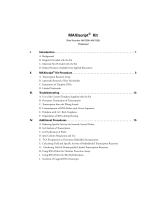 Thermo Fisher Scientific MAXIscript™ Kit User manual
Thermo Fisher Scientific MAXIscript™ Kit User manual
-
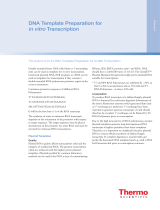 Thermo Fisher Scientific DNA Template Preparation User guide
Thermo Fisher Scientific DNA Template Preparation User guide
-
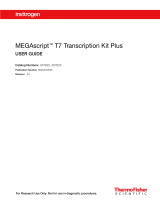 Thermo Fisher Scientific MEGAscript T7 Transcription Kit Plus User guide
Thermo Fisher Scientific MEGAscript T7 Transcription Kit Plus User guide
-
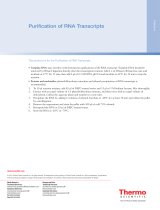 Thermo Fisher Scientific Purification of RNA Transcripts User guide
Thermo Fisher Scientific Purification of RNA Transcripts User guide
-
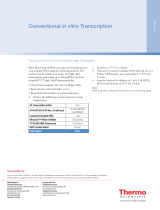 Thermo Fisher Scientific Conventional in vitro Transcription User guide
Thermo Fisher Scientific Conventional in vitro Transcription User guide
-
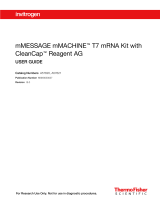 Thermo Fisher Scientific mMESSAGE mMACHINE T7 mRNA Kit User guide
Thermo Fisher Scientific mMESSAGE mMACHINE T7 mRNA Kit User guide
-
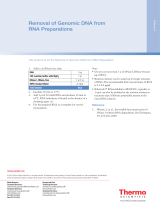 Thermo Fisher Scientific Removal of Genomic DNA User guide
Thermo Fisher Scientific Removal of Genomic DNA User guide
-
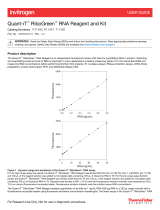 Thermo Fisher Scientific Quant-iT RiboGreen RNA Reagent and Kit User guide
Thermo Fisher Scientific Quant-iT RiboGreen RNA Reagent and Kit User guide
-
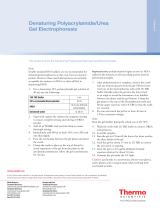 Thermo Fisher Scientific Denaturing Polyacrylamide/Urea Gel Electrophoresis User guide
Thermo Fisher Scientific Denaturing Polyacrylamide/Urea Gel Electrophoresis User guide
-
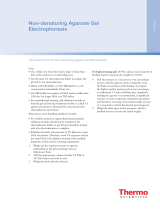 Thermo Fisher Scientific Non-denaturing Agarose Gel Electrophoresis User guide
Thermo Fisher Scientific Non-denaturing Agarose Gel Electrophoresis User guide
Other documents
-
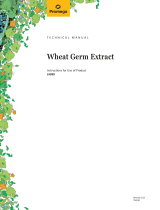 Promega L4380 User manual
Promega L4380 User manual
-
 Takara Bio Cellartis iPSC rCas9 User manual
Takara Bio Cellartis iPSC rCas9 User manual
-
GE RPN160A User manual
-
Roche LightCycler 480 / 1536 User manual
-
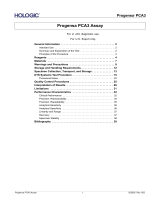 Hologic Progensa PCA3 Assay Operating instructions
Hologic Progensa PCA3 Assay Operating instructions
-
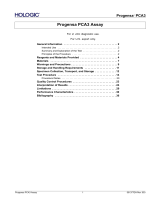 Hologic Progensa PCA3 Assay Operating instructions
Hologic Progensa PCA3 Assay Operating instructions
-
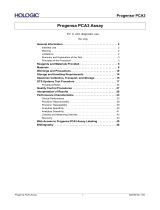 Hologic Progensa PCA3 Assay Operating instructions
Hologic Progensa PCA3 Assay Operating instructions
-
Promega AM2140 User manual
-
Roche KAPA RNA HyperCap Workflow v1.0 User manual
-
Omni Bead Mill Bacterial RNA Kit User manual


















































